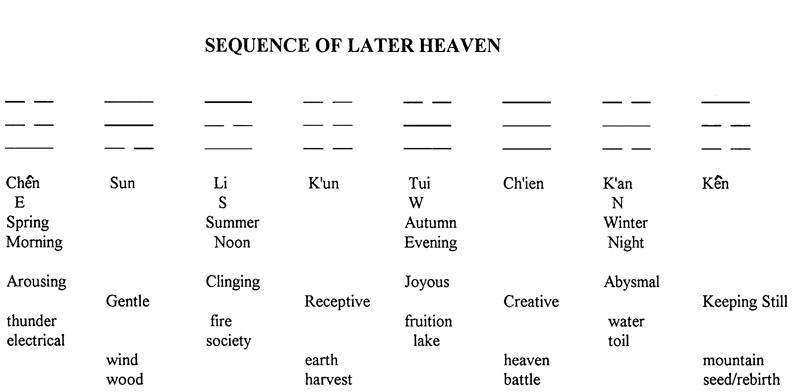The title refers to the arrangement of trigrams in the I Ching known as the Inner-World Arrangement, through which the primal arrangement based on opposites, the Sequence of Earlier Heaven, shines. In the later arrangement, the trigrams are shown in a temporal progression that follows the seasons and times of day. In the musical work, this progression takes place in 8 sections, each a hundred seconds in length and contrasting in character.
The sequence opens with the Arousing, signifying spring and morning, energized by thunder and electrical energy, and is followed by the Gentle, which finds its image in wind and wood, symbolizing organic development. Midsummer, or high noon, is evoked by the trigram known as the Clinging, referring to the light toward which the ruler of society turns, as organic life gives way to human consciousness. This is followed by the Receptive, which refers to the earth and the season of harvest, and in turn leads to the Joyous, as the year produces fruition and happiness. An abrupt change focusses on the Creative, symbolizing heaven, where the stern judgement of a battle between the forces of light and darkness is being fought. Winter ensues with the trigram of the Abysmal, where everything seeks its lowest level and the fullest concentration. The sequence ends with the trigram Keeping Still, symbolized by the Mountain, where the seeds of the new year and the new day are born.
The composer is grateful to Sal Ferreras,
Russell Hartenberger and Randy Raine-Reusch who provided the
source material for this work, along with the Simon Fraser
University gamelan, Kyai Madu Sari (The Venerable
Essence of Honey). The work was commissioned with the
assistance of the Canada Council by Al Mattes and the Music
Gallery in Toronto, for the 1993 Canadian Electroacoustic
Community's Radio Days, and is dedicated to the memory of
Martin Bartlett.

Sequence of Later Heaven is available on
the Cambridge Street Records CD Song of Songs and the opera CD Powers of Two.
 Sound Example available
plus complete documentation on the WSP Database
(truax@sfu.ca for guest access)
Sound Example available
plus complete documentation on the WSP Database
(truax@sfu.ca for guest access)
* Note: an 8-channel version of this work is available, created with the DM-8 computer-controlled diffusion system.
Technical note
The work was realized using the composer's PODX system which incorporates the DMX-1000 Digital Signal Processor controlled by a PDP Micro-11 computer. The principal signal processing technique involves time stretching and harmonizing of the sampled sounds with software for real-time granular synthesis developed by the composer in the School for the Contemporary Arts at Simon Fraser University. Sound densities around 250 events/second per stereo pair were recorded on 8-track tape (producing vertical densities ranging from 200 to 400 sounds) and mixed down in the Sonic Research Studio at SFU.